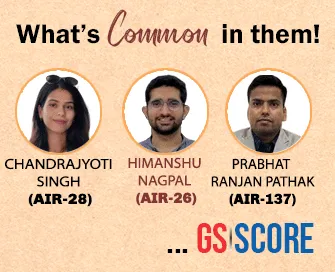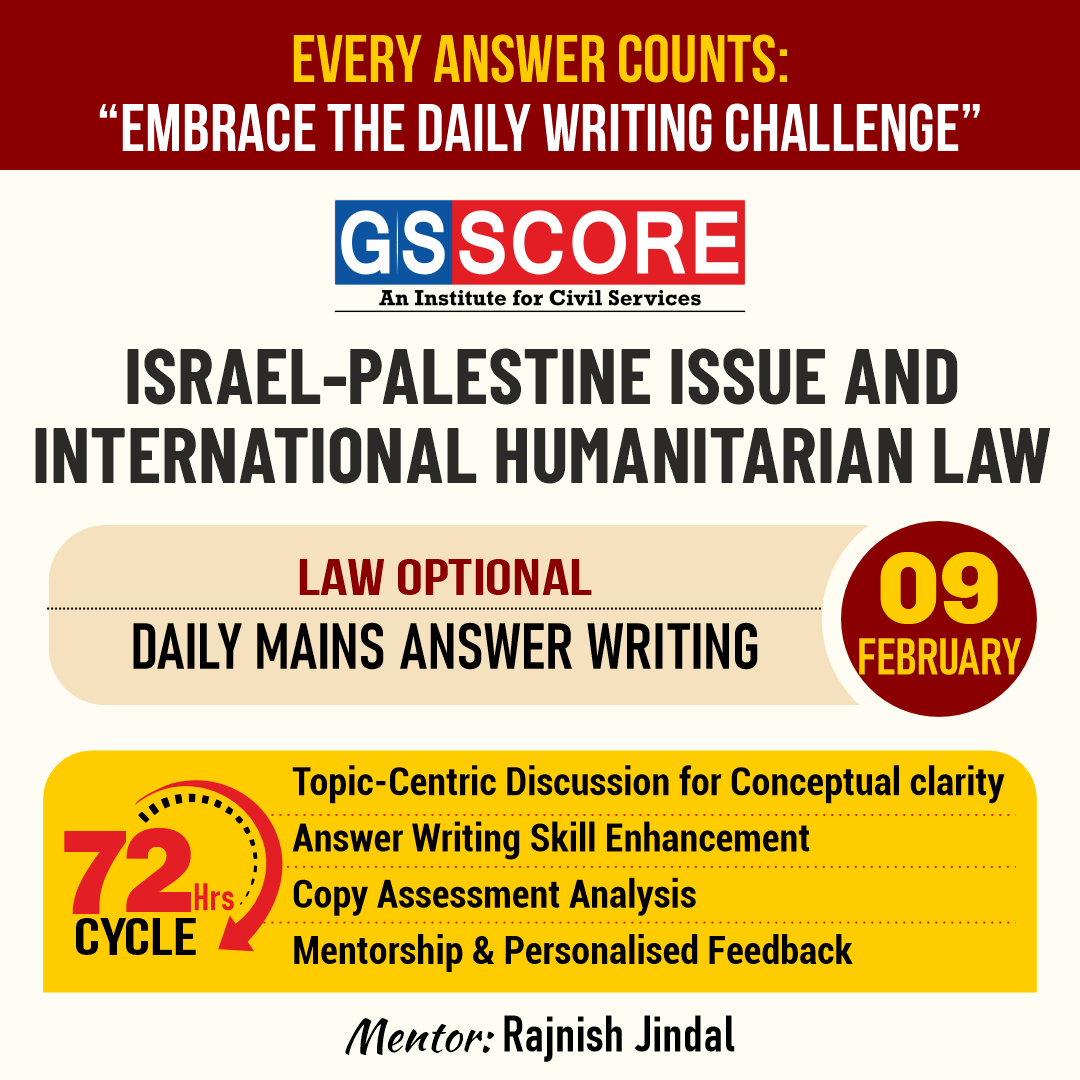


Instruction:
- There will be 2 questions carrying the First Question is-10 marks Write your answers in 150 words and the Second Question is-15 marks Write your answers in 250 words.
- Any page left blank in the answer-book must be crossed out clearly.
- Evaluated Copy will be re-uploaded on the same thread after 2 days of uploading the copy.
- Discussion of the question and one to one answer improvement session of evaluated copies will be conducted through Google Meet with concerned faculty. You will be informed via mail or SMS for the discussion.
Question #1. How Does International Humanitarian Law Apply in Israel and Gaza? Critically analyze the role of International Humanitarian Law and role of International Criminal Court in such situations. 10 marks (150 words)
Question #2. “The rules of the humanitarian law of war have clearly acquired the status of juscogens’, for they are the fundamental rules of a humanitarian character, from which no derogation is possible without negating the basic considerations of humanity which they are intended to protect.”Evaluate the above statement. 15 marks (250 words)
(Examiner will pay special attention to the candidate's grasp of his/her material, its relevance to the subject chosen, and to his/ her ability to think constructively and to present his/her ideas concisely, logically and effectively).
STEPS & INSTRUCTIONS for uploading the answers
Step 1 - The Question for the day is provided below these instructions. It will be available at 7:00 AM.
Step 2 - Uploading of Answers : Write the answer in A4 Sheet leaving proper margins for comments and feedback and upload the PDF in MY ACCOUNT section. Click on the option of SUBMIT COPY to upload the PDF.
Step 3 - Deadline for Uploading Answers: The students shall upload their answers by 7:00 PM in the evening same day. The first 50 copies will be evaluated.
Step 4 - Feedback : Mentors will give their feedback for the answers uploaded. For more personalised feedback, join our telegram channel by clicking on the link https://t.me/mains_answer_writing_cse . A one-to-one session will be conducted with the faculty after copy evaluation in 72 Hrs.
Model Answer
Question #1. How Does International Humanitarian Law Apply in Israel and Gaza? Critically analyze the role of International Humanitarian Law and role of International Criminal Court in such situations. 10 marks (150 words)
War crimes laws applicable to the Israel-Palestinian conflict: Hamas and Israel have both been accused of breaking international law during their latest conflict, and the United Nations says it is collecting evidence of war crimes by all sides. The rules of armed conflict are governed by a set of internationally recognised laws and resolutions, including the United Nations charter, which prohibits aggressive wars but allows countries the right to self-defence and more specifically the law governing armed conflict and military occupation is known as ‘international humanitarian law’ (IHL). The central tenet of IHL is that parties to a conflict must distinguish at all times between combatants and civilians. All possible precautionary measures must be taken to minimise harm to civilians, and attacks causing disproportionate harm to them as compared to any anticipated military gain are prohibited.
The genesis of this legal framework lies in treaties dating back to the 19thcentury, but its modern version has been codified in the 1949 Geneva Conventions, which came into being after crimes against humanity were committed in the Second World War. The four conventions agreed upon in 1949 set out that civilians, the wounded, and prisoners must be treated humanely in wartime. They ban murder, torture, hostage-taking, and “humiliating and degrading treatment” and require fighters to treat the other side's sick and wounded.
The rules apply both to wars between nations and conflicts, like that between Israel and Hamas, in which one of the parties is not a state.Another key document in the law of war is the founding Rome Statue of the International Criminal Court, which defines as war crimes acts including intentional attacks on civilians, civilian settlements, or humanitarian workers, destroying property where not militarily necessary, sexual violence and unlawful deportation.
Article 3 of the Geneva Conventions of 1949, which is common to all four Conventions, extends protection to civilians and persons no longer taking part in hostilities, such as captured combatants, and those who have surrendered or become incapacitated. This includes the prohibition of violence such as murder, cruel treatment, and torture against such persons well as a violation of their personal dignity and the taking of hostages.
Notably, the ‘principle of non-reciprocity’ is inherent in these laws, which means that violations by one side such as deliberately targeting civilians or imposing collective punishment do not justify violations by another. The laws make no formal distinction between parties to a conflict on the basis of power imbalances, as it could virtually negate the rules of war.
Role of the ICC: The Netherlands-based ICC has the power to prosecute nations' officials for violations and order compensation for victims. But some countries – including the United States, Russia, and Israel do not recognise the court's jurisdiction, and the ICC does not have a police force to execute arrest warrants. The ICC has had an ongoing investigation into allegations of war crimes and crimes against humanity committed in the occupied Palestinian territories since 2021.It has not issued any arrest warrants.Prosecutors said in 2021 there was a reasonable basis to believe that violations had been committed on all sides, including by Israeli troops, Hamas militants and other armed Palestinian groups.The ICC recognises Palestine as a member state, while Israel rejects the court’s jurisdiction and does not formally engage with it.However, The ICC’s founding Rome Statute gives it legal authority to investigate alleged crimes on the territory of its members or by their nationals, when domestic authorities are “unwilling or unable” to do so.
Question #2. “The rules of the humanitarian law of war have clearly acquired the status of juscogens’, for they are the fundamental rules of a humanitarian character, from which no derogation is possible without negating the basic considerations of humanity which they are intended to protect.”Evaluate the above statement. 15 marks (250 words)
International Humanitarian Law (IHL), also known as the law of war, law of armed conflict or the jus in bello, is the body of international law that applies in armed conflict. IHL accepts that parties to an armed conflict will need to use force to ‘win the war’ and that this will likely result in some death and destruction. To minimise this likely harm, IHL regulates how wars are fought.In addition to prescribing laws governing resort to force (jus ad bellum), international law alsoseeks to regulate the conduct of hostilities (jus in bello). These principles cover, for example, thetreatment of prisoners of war, civilians in occupied territory, sick and wounded personnel,prohibited methods of warfare and human rights in situations of conflict. This subject wasoriginally termed the laws of war and then the laws of armed conflict. More recently, it has beencalled international humanitarian law.
IHL is one of the oldest bodies of modern international law, with the first treaties entering into force in the mid-nineteenth century. Two of these original treaties reflect the two driving premises described above. Henry Dunant for the first time in 1862 came ahead and published Un Souvenir de Solférino as he was deeply moved by the battle fought in Solférino and it’s consequences along with proposing that nations at war during the wartime should mandatorily form some kind of relief societies or temporary nursing facilities to provide due care to the wounded soldiers and citizens. This exact incident first led towards establishing the International Red Cross in 1863 and then Geneva Conventions in 1864. The first, the Geneva Convention of 1864, protected those injured on the battlefield. It also provided the legal basis for the provision of medical aid and the protection of those providing it. The second, the 1868 St Petersburg Declaration, introduced the first restriction on the use of a weapon for humanitarian reasons and founded the prohibition on unnecessary suffering.Although The first attempt to bring together existing laws and customs of war in a document, and to impose them on an army in battle, was the “Lieber Code” (1863). This was intended solely for Union soldiers fighting in the American Civil War, and as such did not have the status of a treaty. In 1864 the first Geneva Convention “for the Amelioration of the Condition of the Wounded in Armies in the Field”, for the first time introduced the idea of having an IHL and also explained the need of having the same. The first Geneva Convention was a success as twelve nations came together agreeing on certain principles and rules to maintain during wartime along with agreeing to guarantee neutrality to medical personnel during war and signed the Convention. In that same convention, they also adopted a special emblem to mark this togetherness of the nations and this emblem, later on, became the symbol of the International Red Cross Society in 1870.
After the first Geneva Convention, The Hague Peace Conferences in 1899 and 1907 led to The Hague Conventions which worked and implementations of various international treaties introduced in the previously held Peace Conferences to govern the conduct of war. There were many Principles or Rules or limitations on armaments among the countries at war during the wartime was put up as proposals and based on the votes of the countries present at the conventions they were included as terms in the international treaties between the countries at war, for example, a prohibition on the use of air bombs and chemical warfare was proposed as it the consequences of using such weapons was previously observed. In conclusion, these two Conventions laid down a basic practice of having meetings with representatives from multiple Nations and discuss the interstate policies and form International Laws to be followed by all the present nations. These Conventions, in reality, paved the way for the formation of the League of Nations after World War I in 1919.
After World War II the governments adopted the four Geneva Conventions of 1949 rewriting the existing convention with the agenda of protecting civilians during warfare when they find themselves under the control of the enemy State. The Geneva Conventions of 1949 was adopted by every single Nation in the world and it was after the formation of the United Nations in the year 1945 the Protocols proposed, had a very broad acceptance and their provisions are considered as customary law to be implemented in the respective countries by the respective Governments.
The Geneva Conventions are a set of four treaties, formalised in 1949, and three additional protocols, the first two of which were formalised in 1977 and the third in 2005, which codify widely accepted ethical and legal international standards for humanitarian treatment of those impacted by any ongoing war. The focus of the Conventions is the treatment of non-combatants and prisoners of war, and not the use of conventional or biological and chemical weapons, the use of which is governed respectively by the Hague Conventions and the Geneva Protocol.
- The First Geneva Convention protects wounded and sick soldiers on land during war. This convention extends to medical and religious personnel, medical units, and medical transport. While recognisingdistinctive emblems of these organisations, the convention has two annexes containing a draft agreement relating to hospital zones and a model identity card for medical and religious personnel.
- The Second Geneva Convention protects wounded, sick and shipwrecked military personnel at sea during war. This convention also extends to hospital ships and medical transports by sea, with specific commentary on the treatment of and protections for their personnel.
- The Third Geneva Convention applies to prisoners of war, including a wide range of general protections such as humane treatment, maintenance and equality across prisoners, conditions of captivity, questioning and evacuation of prisoners, transit camps, food, clothing, medicines, hygiene and right to religious, intellectual, and physical activities of prisoners.
- The Fourth Geneva Convention, which most imminently applies to the invasion of Ukraine by Russian military forces, protects civilians, including those in occupied territory. The other Geneva Conventions were concerned mainly with combatants rather than civilians. However, based on the experience of World War II, which demonstrated the horrific consequences of having no convention for the protection of civilians in wartime, the Fourth Convention comprising 159 articles outlines the norms for this critical dimension of conflict.
- Along with the Additional Protocols of 1977, the Fourth Convention expounds upon the general protection of populations against certain consequences of war, the conduct of hostilities and the status and treatment of protected persons, distinguishing between the situation of foreigners on the territory of one of the parties to the conflict and that of civilians in occupied territory. This convention also spells out the obligations of the occupying power vis-à-vis the civilian population and outlines detailed provisions on humanitarian relief for populations in occupied territory. As the International Committee for the Red Cross, a key medical intermediary in such situations, explains, this convention also contains a specific regime for the treatment of civilian internees, including three annexes on hospital and safety zones, and model regulations on humanitarian relief.
IHL and ICC: Under Article 8 of the Rome Statute of the ICC, it is the ICC that has jurisdiction in respect of war crimes, in particular “when committed as part of a plan or policy or as part of a large-scale commission of such crimes.” Under the statute, ‘war crimes’ refers to “Grave breaches of the Geneva Conventions… including wilful killing, torture or inhuman treatment, including biological experiments; wilfully causing great suffering, or serious injury to body or health; extensive destruction and appropriation of property, not justified by military necessity and carried out unlawfully and wantonly; compelling a prisoner of war or other protected person to serve in the forces of a hostile Power; wilfully depriving a prisoner of war or other protected person of the rights of fair and regular trial; unlawful deportation or transfer or unlawful confinement; taking of hostages.”
The statute goes beyond these crimes directed against individuals to include within the definition of ‘war crimes’ broader acts that occur within armed conflict, including intentionally directing attacks against the civilian population or against individual civilians not taking direct part in hostilities, such as attacking or bombarding towns, villages, dwellings or buildings which are undefended and which are not military objectives; and intentionally directing attacks against personnel, installations, material, units or vehicles involved in a humanitarian assistance or peacekeeping mission in accordance with the Charter of the United Nations, especially when it is in the knowledge that such attack will cause incidental loss of life or injury to civilians or damage to civilian objects or widespread, long-term and severe damage to the natural environment.

